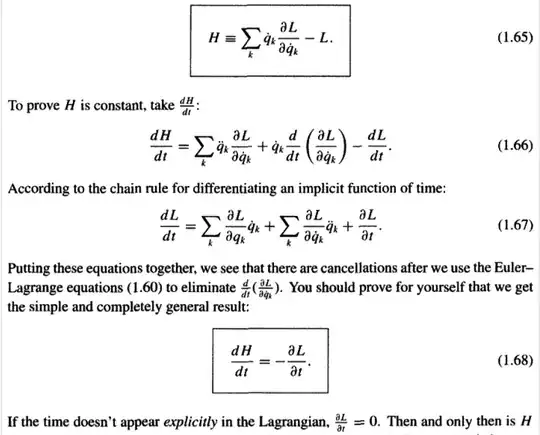Let $L:\Bbb{R}^n\times\Bbb{R}^n\times\Bbb{R}\to\Bbb{R}$ be a given smooth map. I’m going to use the notation $(x,v,t)$ to denote a point in $\Bbb{R}^n\times\Bbb{R}^n\times\Bbb{R}$. I hope you agree that we can now consider the $2n+1$ many partial derivative functions $\frac{\partial L}{\partial x^1},\dots \frac{\partial L}{\partial x^n}, \frac{\partial L}{\partial v^1},\dots \frac{\partial L}{\partial v^n},\frac{\partial L}{\partial t}: \Bbb{R}^n\times\Bbb{R}^n\times\Bbb{R}\to\Bbb{R}$. Don’t get ‘confused’ by the notation $x^i,v^i,t$. So far there’s nothing at all to suggest anything means position, velocities, time or Lagrangian. I just have a function of $(2n+1)$ many variables in the domain and as output I spit out a real number, and I can consider the corresponding partial derivatives.
From the given map $L$, I’m going to define a new map $E:\Bbb{R}^n\times\Bbb{R}^n\times\Bbb{R}\to\Bbb{R}$ by the formula
\begin{align}
E(x,v,t):=\sum_{i=1}^nv^i\frac{\partial L}{\partial v^i}\bigg|_{(x,v,t)} - L(x,v,t)\tag{1.6.5}
\end{align}
(and as mentioned in the link, I really would like to avoid $H$ here because that’s again another source for confusion; the function $E$ here is intuitively ‘defined in terms of positions and velocities’, rather than ‘position and momenta’, i.e this is a Physics issue which hand & Finch should emphasize (I hope they did)). So far all I did is start with one function $L$, and used it to construct a new function $E$. Nothing magical here.
Next, suppose we have a smooth function $\gamma:\Bbb{R}\to\Bbb{R}^n$ such that for all $i\in\{1,\dots, n\}$ and all $t\in\Bbb{R}$
\begin{align}
\frac{d}{dt}\bigg(\frac{\partial L}{\partial v^i}\bigg|_{(\gamma(t),\dot{\gamma}(t),t)}\bigg)-\frac{\partial L}{\partial x^i}\bigg|_{(\gamma(t),\dot{\gamma}(t),t)}&=0.\tag{$*$}
\end{align}
See here (and the sublinks within) for a more detailed explanation of what exactly we mean here with the Euler-Lagrange equations, if you need it.
Ok perfect, so we now have three functions $L,E,\gamma$ in play here. Let me now define two new function $L_{\gamma},E_{\gamma}:\Bbb{R}\to\Bbb{R}$ as the following composition:
\begin{align}
L_{\gamma}(t):=L(\gamma(t),\dot{\gamma}(t),t),\quad\text{and}\quad E_{\gamma}(t)&:=E(\gamma(t),\dot{\gamma}(t),t)\\
&=\sum_{i=1}^n\dot{\gamma}^i(t)\frac{\partial L}{\partial v^i}\bigg|_{(\gamma(t),\dot{\gamma}(t),t)}- L_{\gamma}(t).
\end{align}
Note that the final equal sign simply used the definitions. Now we can start differentiating things
\begin{align}
E_{\gamma}’(t)&=\frac{d}{dt}\left(\sum_{i=1}^n\dot{\gamma}^i(t)\frac{\partial L}{\partial v^i}\bigg|_{(\gamma(t),\dot{\gamma}(t),t)}- L_{\gamma}(t)\right)\\
&=\left[\sum_{i=1}^n\ddot{\gamma}^i(t)\frac{\partial L}{\partial v^i}\bigg|_{(\gamma(t),\dot{\gamma}(t),t)}+\sum_{i=1}^n\dot{\gamma}^i(t)\frac{d}{dt}\left(\frac{\partial L}{\partial v^i}\bigg|_{(\gamma(t),\dot{\gamma}(t),t)}\right)\right]\\
&\,\,\,-\left[\sum_{i=1}^n\frac{\partial L}{\partial x^i}\bigg|_{(\gamma(t),\dot{\gamma}(t),t)}\cdot\dot{\gamma}^i(t)+
\sum_{i=1}^n\frac{\partial L}{\partial v^i}\bigg|_{(\gamma(t),\dot{\gamma}(t),t)}\cdot\ddot{\gamma}^i(t) +
\frac{\partial L}{\partial t}\bigg|_{(\gamma(t),\dot{\gamma}(t),t)}\cdot 1\right]\\
&=-\frac{\partial L}{\partial t}\bigg|_{(\gamma(t),\dot{\gamma}(t),t)}.
\end{align}
The first square brackets just used the product rule and the second square brackets just used the chain rule (see this answer for remarks on how to write the chain rule from most precise to least precise, notation-wise). To get from the second to third equal sign, note that the first term cancels with the fourth, and after using the Euler-Lagrange equations (*) for the second term it cancels with the third term. Hence, we get our desired result:
\begin{align}
E_{\gamma}’(t)&=-\frac{\partial L}{\partial t}\bigg|_{(\gamma(t),\dot{\gamma}(t),t)}\tag{1.6.8}
\end{align}
So, if you’re so lazy as to omit all instances of the curve $\gamma$, then you could write this as the confusing equality $\frac{dE}{dt}=-\frac{\partial L}{\partial t}$.
In the comments, you ask
so how can we treat $L$ once as if it doesn't have an explicit dependency on $t$, but then even take the total derivative with respect to $t$
I hope you’re now convinced that is not what we’re doing. You’re getting confused because you (because of the book) keep using the same letter $L$ to mean different things. For the function $L$, I can (as I mentioned in the very first paragraph), consider any of its $(2n+1)$ many partial derivatives, in particular its last one $\frac{\partial L}{\partial t}$. The function $L_{\gamma}$ is a completely different function from $L$ (it has a different domain $\Bbb{R}$ vs $\Bbb{R}^n\times\Bbb{R}^n\times\Bbb{R}$) obtained via composition; and it is a function of only one variable so I can only consider its derivative $L_{\gamma}’$ (i.e $\frac{dL_{\gamma}}{dt}$), and to relate $L_{\gamma}’$ to the various partials derivatives of $L$, I simply use the chain rule.
The ultimate theorem is saying that if $\frac{\partial L}{\partial t}=0$ identically, then for every curve $\gamma$ satisfying the Euler-Lagrange equations (*), we have $E_{\gamma}’=0$, and hence $E_{\gamma}$ is a constant function (i.e energy is conserved).
A very common situation which arises is we first start with a smooth function $L_0:\Bbb{R}^n\times\Bbb{R}^n\to\Bbb{R}$. Then, we define a new function $L: \Bbb{R}^n\times\Bbb{R}^n\times\Bbb{R}\to\Bbb{R} $ by the formula $L(x,v,t):=L_0(x,v)$. So, clearly, the value of $L(x,v,t)$ does not depend on $t$, and thus $\frac{\partial L}{\partial t}=0$ identically, so in this case, we have energy conservation (i.e $E_{\gamma}$ is constant, where $E$ and $E_{\gamma}$ have been defined above in terms of $L$).
